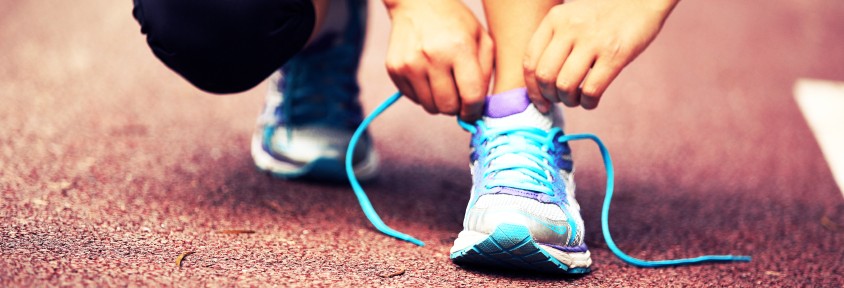
What kind of shoes or sneakers do you wear when you exercise? Your answer to the above question should depend on what kind of exercise you do. If you do more than one kind, you should have more than one pair of shoes or sneakers, according to many experts.
Of course, you might not have the money to buy several pairs of sneakers. You also might not have the time. If you have the time and money, though, buying more than one pair of exercise footwear could be a very smart investment. Different footwear for different exercises, in fact, could significantly improve your performance in all of your activities. Specialized footwear could also reduce the chance you will get injured.
“The single most important piece of equipment in virtually any kind of exercise program — running, aerobics, hiking, tennis, basketball — is the right pair of shoes,” reported WebMD in its article “5 Biggest Mistakes When Choosing Workout Shoes.” “A good pair of sneakers can make or break your workout. And it’s easy to go wrong.”
Different Footwear for Different Exercises
 You need different footwear for different exercises because your feet move differently during different exercises. For example, your feet move forward when you run and rarely move laterally. When you’re playing basketball and tennis, though, your feet move laterally far more often. That’s why running shoes are built differently than basketball and tennis shoes. Running shoes have cushions that support your feet as they move forward. However, they’re not designed to give your feet lateral stability. Basketball and tennis shoes are.
You need different footwear for different exercises because your feet move differently during different exercises. For example, your feet move forward when you run and rarely move laterally. When you’re playing basketball and tennis, though, your feet move laterally far more often. That’s why running shoes are built differently than basketball and tennis shoes. Running shoes have cushions that support your feet as they move forward. However, they’re not designed to give your feet lateral stability. Basketball and tennis shoes are.
You also move your feet far differently when you walk than when you run. In “The Complete Guide to Walking,” author Mark Fenton pointed out that the force of impact when your feet hit the ground is three to four times your weight when you run, but only one to 1.5 times your weight when you walk. This means that running shoes should have thicker heels and more cushioning than walking shoes.
Here are some recommendations for how to find the right footwear for you:
- Walking shoes should have as much toe spring as possible, wrote Fenton. The host of the PBS television series “America’s Walking” recommended testing shoes’ toe spring when you shop by pushing a finger on them. Toe spring is measured by how far the heel is off the ground after you push the shoe.
- Walking shoes should also have low and rounded heels. Fenton recommends testing the heels by pushing a finger on their inside cup. The heels are “adequately rounded” if the toes are lifted off the floor after you push the heels.
- Choosing hiking shoes rather than walking shoes is advised if you regularly hike on trails. Hiking shoes, or boots, should have stiffer and thicker soles than walking shoes and higher tops to protect your ankles, reports Fenton. “How to Pick the Perfect Shoe for Any Workout” gives readers specific advice on what shoes to wear for light hiking, heavier hiking, backpacking, and mountaineering. Backpacking and mountaineering shoes have stiffer midsoles.
- The kind of running shoe you buy often depends on how you run, according to “Running Shoe vs. Walking Shoe.” “Runners who strike with their heel or mid-foot should look for less built-up heels, while those who land on the ball of their foot need a more built-up heel,” the article reports.
- Running shoes and walking shoes for people who hike on trails should have a flared heel. Flared heels are particularly beneficial to people whose feet hit the ground at mid-foot. People who have walking shoes for fitness walking do not need flared heels, the “Running Shoe vs. Walking Shoe” article reports.
- Bicyclists also should be selective about their shoes. The “Perfect Shoe” article reports that casual cyclists don’t need bicycling-only shoes, but road cyclers need lightweight shoes with very stiff soles and mountain bikers need moderately stiff soles.
- Soccer players should look for “extremely flat” shoes with flexible rubber outsoles, says “The Perfect Shoe” article.
- Tennis players should look for lightweight sneakers with low-cut ankles and firm but thin rubber soles.
- Basketball players should look for specific basketball sneakers that have a “shock-absorbing midsole.” These specific kinds of shoes are needed so players can make sharp turns while they are minimizing the risk of injuring their ankles.
If you participate in several different exercises, but aren’t serious about any of them, a cross-training shoe is the best choice, according to the “5 Biggest Mistakes” article. A good cross-training shoe should be lightweight but have a firm heel and good support.
These shoes aren’t great for any specific activity. “A good cross-trainer will allow you to do the treadmill, some walking on asphalt or on a track, and light jogging,” ex-American Podiatric Medical Association president Kathleen Stone told WebMd. “I like them for people who are doing a variety of athletic endeavors casually.”
